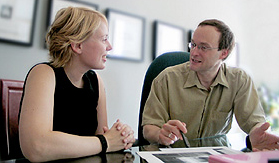From the Ask Tom mailbag –
Question:
In your workshop, you talk about the Manager-Once-Removed, who, you say, has a major role in the hiring process. I have to tell you. My “managers-once-removed” are too busy to participate in the upfront part of recruiting. Why can’t we delegate some of the initial sorting, telephone screening and first round interviews. We usually get the manager-once-removed involved only when the hiring manager is down to the last three candidates.
Response:
What more important function is there, for the manager-once-removed, than to build the infrastructure of the team? I would ask, why is your manager-once-removed so busy? Is it because the MOR did such a lousy job of building the team in the first place.
Lets say we have an open role at S-II, supervisor position. The hiring manager is appropriately at S-III, and the manager-once-removed is the hiring manager’s manager, at S-IV. In the hierarchy, (remember, I’m a structure guy) it looks like this.
S-IV – MOR
S-III – Hiring manager
S-II – Supervisor (Open role)
What pain is occurring?
For the hiring manager (S-III) – a production team is likely running without supervision, meaning the hiring manager has to fill the gap and work down a stratum level of work, at least part time. Simultaneously, the organization is looking to the hiring manager to initiate a recruiting search for a replacement.
For the manager-once-removed (S-IV) – one of the S-III managers (the hiring manager) is currently under stress, spread thin, covering for an open role, making sure production gets done while simultaneously recruiting for that open role.
When does the role need to be filled?
For the hiring manager – yesterday would be good.
For the manager-once-removed – when the right candidate is identified in the candidate pool.
What is the critical purpose for the recruiting effort?
For the hiring manager – to remove the stress in the production system, created by the open role.
For the manager-once-removed – to build a stronger team, finding a truly qualified candidate that creates bench-strength.
What is the hiring methodology?
For the hiring manager – whatever is fastest. Use a job posting for the role description. Hope the hiring team likes the first candidate. How fast can the candidate give notice on their current job? Better yet, are they currently unemployed and can they start tomorrow?
For the manager-once-removed – slow the process down. Make sure the role description is well written and understood, it’s the central document for the process. Create a hiring team with well-understood roles on the team. Use the hiring team to identify the critical role requirements. Use the hiring team to create a bank of interview questions, ten written questions for each Key Result Area. Bring value to the decision making process of the hiring manager.
Who is accountable for the quality (output) of the decision made by the hiring manager?
A manager is that person held accountable for the output of the team. The manager-once-removed is the hiring manager’s manager. It is the manager-once-removed that is accountable for the quality of the decision made by the hiring manager.
Do not leave your hiring manager to twist in the wind. The manager-once-removed is the quarterback of this process. What more important function is there, for the manager-once-removed, than to build the infrastructure of the team?
